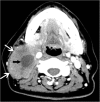Castleman disease versus lymphoma in neck lymph nodes: a comparative study using contrast-enhanced CT
- PMID: 30115111
- PMCID: PMC6097448
- DOI: 10.1186/s40644-018-0163-7
Castleman disease versus lymphoma in neck lymph nodes: a comparative study using contrast-enhanced CT
Abstract
Background: The purpose of this study was to determine the contrast-enhanced CT characteristics for differentiating between Castleman disease (CD) and lymphoma in neck lymph nodes.
Methods: This retrospective study evaluated the number (solitary or multiple), strength of contrast-enhancement, type of contrast-enhancement, surrounding vessels, contrast-enhanced Hounsfield unit (HU) values, and anatomical distributions of lymph nodes in 34 patients with confirmed CD and 55 patients with newly diagnosed untreated lymphoma. Independent t-tests, receiver operating characteristic (ROC) curve analysis, and chi-square tests were used to evaluate the variables and CT features.
Results: Several significant differences were found between CD and lymphoma. The interval between first contrast-enhanced CT and biopsy/surgery was significantly longer in the CD group (mean 72 ± 105 days, median 60 days) than in the lymphoma patients (mean 30 ± 2 days, median 12 days; p = 0.015). The lymphoma patients presented significantly more often with fatigue and fever (p = 0.023 and p = 0.016 respectively) than did the CD subjects. HU values of nodules after enhancement were significantly higher in the CD patients than in the lymphoma patients. In cases involving multiple lymph nodes, in all the CD cases, all affected nodes were located in only the left or right side of the neck, not bilaterally. ROC analysis showed a significant difference in contrast-enhanced CT attenuation values between lymphoma and CD (p < 0.001, area under the curve = 0.954), with a cut-off value of 92.5 HU. We constructed a decision tree according to these imaging characteristics.
Conclusions: Contrast-enhanced CT can be useful for differentiating between CD and lymphoma.
Keywords: Castleman disease; Contrast-enhanced CT; Lymphoma; Neck.
Conflict of interest statement
Ethics approval and consent to participate
Ethical approval was obtained by the local institutional review board (Ethical Committee of Affiliated Hospital of Qingdao University).
Consent for publication
Not applicable.
Competing interests
The authors declare that they have no competing interests.
Publisher’s Note
Springer Nature remains neutral with regard to jurisdictional claims in published maps and institutional affiliations.
Figures









References
-
- Ottaviani F, Galli J, Di Girolamo S, Almadori G. Castleman's disease restricted to the parapharyngeal space. J Otolaryngol. 1999;28(2):95–98. - PubMed
Publication types
MeSH terms
LinkOut - more resources
Full Text Sources
Other Literature Sources
Medical

